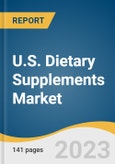Furthermore, the trend towards self-directed care is also driving demand for the dietary supplements in the U.S. Consumers, those are becoming more proactive in managing their health and are turning to supplements as a way to enhancement their diets and maintain optimal health. As consumers take more responsibility for their health, they are seeking out natural and alternative remedies to improve their health and wellness.
Nutraceutical supplements have received immense popularity and focus in the recent past owing to their nutritional and medicinal benefits, along with being safe for consumption without any significant side effects. Nutraceuticals are also quickly replacing pharmaceuticals in the management and prevention of chronic and acute health problems. These products have ample scope as therapeutic agents with curative and preventive properties. They are generally available over the counter, without requiring a prescription, making them easily accessible to the general public.
The rising health concerns have driven consumers to eat better and lead healthier lives. However, with busy schedules and little time to make healthy, nutritious meals, consumers are relying on dietary supplements to make up for the inadequate intake of the required nutrients. Apart from this. The growing trend of personalized nutrition and the increased spending power of the consumers are expected to have a positive impact on product demand. There is a rising willingness among consumers in the U.S. to pay a premium price for products with better nutritional value. Add to this the growing tendency of companies to use eye-catching packaging and natural ingredients to attract more consumers. This will continue to drive the product adoption in the country.
Nanoencapsulation and microencapsulation technologies have gained popularity during the past few years owing to the controlled release and minimum utilization of the ingredients. The introduction and application of encapsulation technologies in the fortification of food & beverage products offer sports nutrition ingredients immense scope for the growth. Furthermore, ascending demand for the naturally derived ingredients in light of increasing health concerns related to synthetic ingredients is expected to fuel the penetration of herbal supplements in the sports nutrition industry.
Mounting health concerns stemming from hectic work schedules and unhealthy eating habits have increased consumer focus on health and fitness. Rising cases of obesity in the country have also driven people to exercise more. This rising participation of consumers in various physical activities, coupled with increasing international and national sporting events, has propelled demand for the sports nutritional supplements.
U.S. Dietary Supplements Market Report Highlights
- Based on ingredient. The market is segmented into vitamins, botanicals, minerals, proteins & amino acids, fibers & specialty carbohydrates, omega fatty acids, probiotics, and others. In 2022. The vitamin segment dominated the market with a revenue share of above 30.11%. Vitamins are a popular dietary supplement among those who may not get all the necessary nutrients from their diet alone. Additionally, certain vitamins like A, B, C, and D are expected to gain more popularity among working professionals and sportspersons due to their potential health benefits related to immunity, bone health, and brain function
- Based on form. The market is segmented into tablets, capsules, soft gels, powders, gummies, liquid, and others. The capsules segment dominated the market with a revenue share of 30.30% in 2022 and is expected to retain its dominance during the forecast period owing to their convenience and design, which protect the active ingredients from light, moisture, and oxygen, thus preserving their potency and quality over time and leading to increased shelf-life
- Based on application. The general health segment dominated the market with a revenue share of 23.66% in 2022 owing to the increasing emphasis on overall health and wellness. This trend is mainly driven by the changing consumer dietary habits, as many people are seeking preventive healthcare measures to maintain their overall health and well-being
- Based on end user. The adults dominated the market with a revenue share of 46.23% in 2022 owing to an increased awareness among working professionals and athletes about the importance of maintaining a balanced diet and the resulting demand for the dietary supplements to support their overall health
- Based on type. The OTC (Over-the-Counter) segment dominated the market with a revenue share of 85.17% in 2022. OTC supplements are often more affordable than prescription supplements, making them an attractive option for consumers
- Based on distribution channel. The offline distribution channel dominated the market with a revenue share of 78.13% in 2022. An increase in prescribed dietary supplements by the medical practitioners for treating gastrointestinal disorders, immunity-related issues, bone health, folic acid deficiencies, heart health, and age-related macular degeneration, among others, is a key factor driving demand for the dietary supplements through offline distribution channels
Table of Contents
Companies Mentioned
- Amway
- Abbott
- Bayer AG
- Glanbia plc.
- Pfizer Inc.
- Archer Daniels Midland (ADM)
- GSK plc.
- NU SKIN
- Herbalife Nutrition
- Nature's Sunshine Products, Inc.
- DuPont de Nemours Inc.
- NOW Foods
Methodology

LOADING...
Table Information
| Report Attribute | Details |
|---|---|
| No. of Pages | 141 |
| Published | April 2023 |
| Forecast Period | 2022 - 2030 |
| Estimated Market Value ( USD | $ 50.91 Billion |
| Forecasted Market Value ( USD | $ 78.94 Billion |
| Compound Annual Growth Rate | 5.7% |
| Regions Covered | United States |
| No. of Companies Mentioned | 12 |









